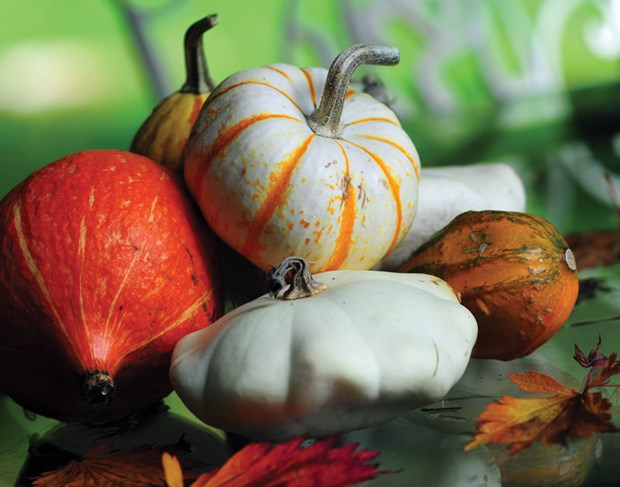Spruce up this year's frightful Friday festivities with some Halloweenthemed plants to delight and scare your guests.
At this time of year it can be difficult to find Halloween-themed plants but it's not impossible. You have to be a little more creative and move beyond the traditional orange and black colours of Halloween.
Indoors, few plants can engage guests better than a Venus flytrap (Dionaea muscipula). The carnivorous flytrap has gnarly looking claw-like leaves with sensitive trigger hairs ready to snare unsuspecting insects. It's one of nature's few carnivorous plants that traps insects in its leaves to be eaten by slow dissolve digestion.
For a creepy but fun experience, have your guest gently touch the flytrap's leaf hairs and watch as the leaf springs closed on their unsuspecting fingers. However, over-stimulating the same leaf without a food reward, like an insect, may cause that leaf to become unresponsive to touch, changing to become photosynthetic only and no longer used for insect digestion.
Another cool insectdigesting plant is called the Cobra plant (Darlingtonia californica) because it looks like a rearing cobra snake. Darlingtonia has tall tube-shaped leaves that emit a sweet fragrance to attract insects into the tube to drown to death in a toxic digestive solution. Often called a "pitfall" carnivorous plant, the Cobra plant is native to northern California and southern Oregon. If you ever make your way to Oregon visit the Darlingtonia State Natural Site in Oregon to see Cobra plants growing in the wild. You can occasionally buy Cobra plants in the water plant section of local garden centres.
For the traditional orange and black colour scheme use pumpkins and gourds as a starting point to frame the rest of the display. Choose pumpkins of varying sizes and shapes to provide interest for the viewer. Carve some and don't carve others. You can also spray paint some pumpkins or gourds white to look like ghost-kins.
Gourds on the other hand are not widely popular with everyone. Some people like gourds while others find them a little gross. Regardless of your taste, choose gourds for Halloween based on their "gross out" factor to add to the spooky atmosphere. I like lots of gourds placed in plant pots, baskets or sprawled on the ground as if trying to escape the party.
There are plenty of dried seeds and fruits to use for Halloween. One of the coolest cuts comes from the Chinese lantern plant (Physalis alkekengi). Physalis is not one of my favourites to grow in the garden due to its spreading habit. So I usually contain it by planting inside some form of buried-in-the-ground containment like plastic or metal edging. Despite its habit, there is no other plant that produces such cute bright orange fruits shaped like a little Japanese lantern or pumpkin. The Chinese lantern's orange fruit covering slowly ages and dries to reveal a small reddish fruit inside of a ghostly white covering of skeletal veins. So both forms of the fruit can be used for display.
Late fall can be a tough time to find hardy Halloween-themed plants but there are a few. Black mondo grass (Ophiopogon planiscapus 'Nigrescens') forms a loose mound of narrow, grass-like black leaves. It grows approximately 15 centimetres or six inches tall. It's best planted in bright light conditions in the garden to retain the black leaf colour as it fades to green in too much shade.
Mondo grass can be bought or dug from the garden to be relocated into hallowed displays.
After many attempts at breeding, there are some black or near-black pansies on the market. Several varieties are sold at garden centres including Black Accord, Black Prince and Black Magic. Best planted in pots near the front door to keep them out of the rain, black pansies will flower from now until spring. To show off their black flowers, plant them with orange pansies, near pumpkins and with other contrasting colours.
Other plants with black, or at least dark purplered foliage, include some ornamental cabbages and some edible kales. And there's the dark purple to deep burgundy-leaved carpet bugle (Ajuga reptans). It's a sweet little groundcover, growing 10 centimetres or four inches tall with a preference for bright morning sun and partial afternoon shade. Choose from dark-leaved varieties like Metallica Crispa, Bronze Beauty or Catlin's Giant and plant at the edge of pots or the front of a planting bed.
There are some rare plants for Halloween like the Dracula orchid (Dracula sergioi), the Voodoo lily (Sauromatum venosum) and the Corpse flower (Amorphophallus titanum) but all are hard to find commercially and require specialist growing knowledge. Rare is not always best, especially at Halloween, so check the garden to find some cuts and clips for your own spooky display.
Todd Major is a journeyman horticulturist, garden designer and builder, teacher and organic advocate. [email protected]



